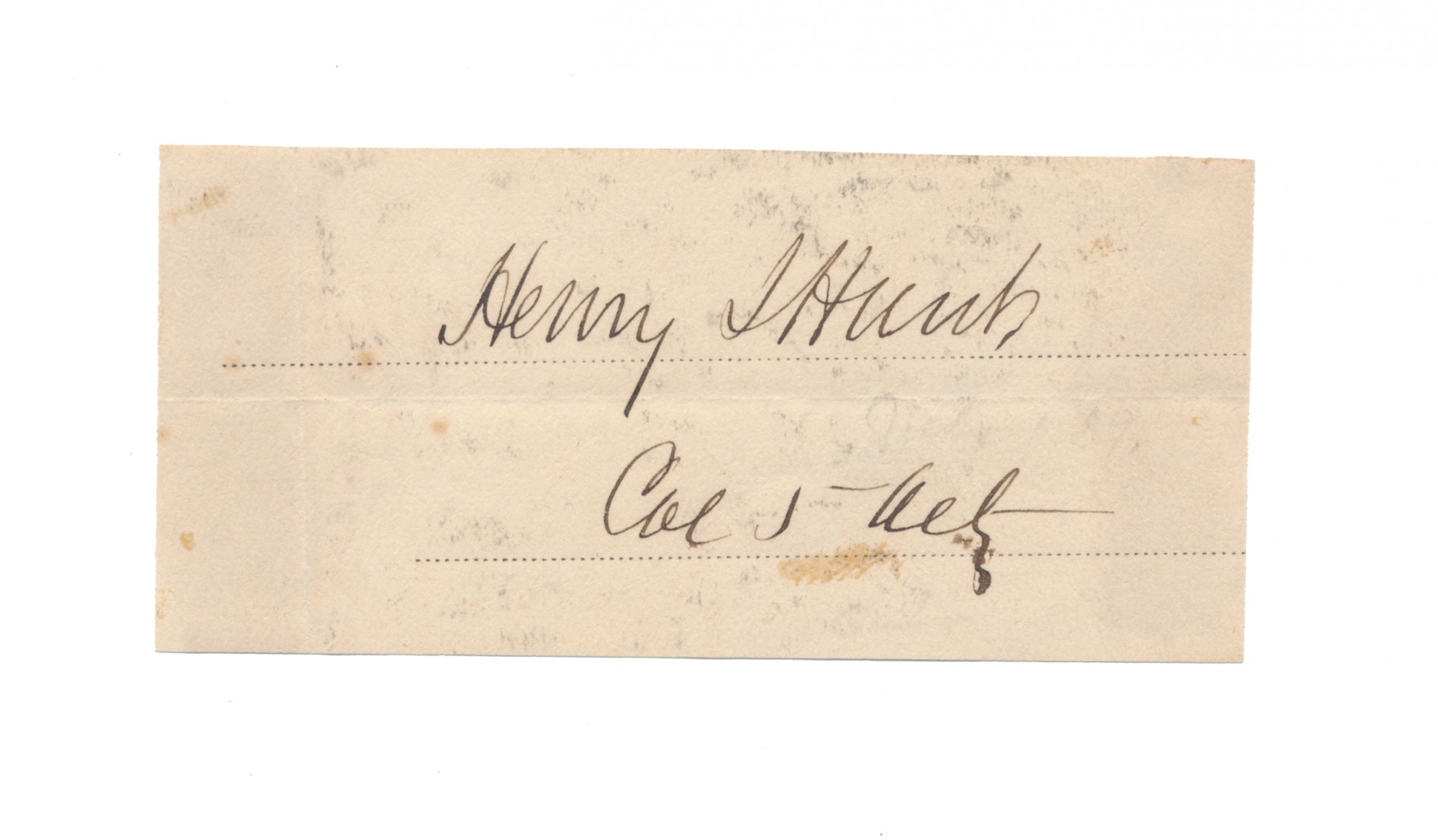site search
online catalog
CLIPPED SIGNATURE – BRIG. GEN. HENRY HUNT

$250.00 SOLD
Quantity Available: None
Item Code: L14616
Signed as Colonel of the 5th US Artillery: “Henry J. Hunt / Col 5 Art”. The 3” x 1 3/8” paper appears to have been clipped from a form/document of some sort. Minor staining, otherwise in very fine condition. Mounting evidence on reverse. This is a post-Civil War signature, as Hunt was appointed Colonel of the 5th US Artillery in 1866.
The deadly accurate guns of the Union artillery were the most feared weapons on Civil War battlefields. Henry Jackson Hunt, the highest-ranking artillery officer in the Union army, was "the man behind the guns"-the military genius who transformed a disorganized artillery corps into the most effective service arm of the army.
Hunt, Henry J., brigadier-general, was born in Detroit, Mich., Sept. 14, 1819. He was graduated at the United States military academy in 1839, served in the Canada border disturbances of that year, and afterwards until the Mexican war was stationed at forts and on recruiting duty, being promoted 1st Lieutenant in 1846. He was brevetted Captain for gallantry at Contreras and Churubusco, and Major for services at Chapultepec, was engaged also at Vera Cruz, Cerro Gordo, San Antonio, Molino del Rey, where he was twice wounded, and in the assault and capture of the City of Mexico.
He was promoted Captain in 1852, was placed in command of Harper's Ferry, Jan. 3, 1861, was promoted Major, May 14, 1861 and in the battle of Bull Run, July 21, 1861, commanded the artillery on the extreme left. After being in charge of the defenses of Washington, July to Sept., 1861, he was placed on the staff of Gen. McClellan, Sept. 28, with the rank of Colonel, and he organized the artillery reserve of the Army of the Potomac, which he commanded at Gaines' Mill. July 27, 1861, and rendered conspicuous service in covering the retreat of McClellan's army to Malvern Hill, at the battle of that place, July 1, 1862, distinguishing himself, and having two horses shot under him. He was promoted Brigadier-General of volunteers in Sept., 1862, and as chief of artillery of the Army of the Potomac was present at Fredericksburg, where he commanded the artillery, posting 147 guns on Stafford Heights, Nov. 21, 1862, and he also commanded the artillery in the Chancellorsville campaign.
Hunt's most famous service in the war was at the Battle of Gettysburg in July 1863 where he was chief of artillery of the Army of the Potomac, and for which he was brevetted Colonel U. S. A. His new commander, Maj. Gen. George G. Meade, had considerably more respect for Hunt than Hooker did and not only gave him great latitude in directing the artillery, but also used him on occasion as his personal representative. For example, on July 2, Meade sent Hunt to visit III Corps commander Maj. Gen. Daniel E. Sickles in an attempt to get his defensive lines to conform to orders. (Sickles' insubordinate movement from Cemetery Ridge, where he had been ordered to defend, to the Peach Orchard caused considerable difficulty for the entire Union defense.) Hunt was unable to influence the irascible political general, but his masterful analysis of terrain and placement of batteries on the ridge were important factors in the Union's eventual success on the second day.
His handling of the artillery was conspicuous in the repulse of Pickett's Charge on July 3. With the Union line on Cemetery Ridge under massive bombardment from Longstreet's corps artillery chief, Col. Edward Porter Alexander, Hunt was able to resist command pressure from fiery II Corps commander Maj. Gen. Winfield S. Hancock who had demanded Union fire to lift the spirits of the infantrymen pinned down under Alexander's bombardment. Hunt ordered that counter-battery fire cease to conserve ammunition, reserving sufficient amounts for anti-personnel fire in the attack he knew was coming. Hunt also directed his cannons to cease fire slowly to create the illusion that they were being destroyed one by one, which fooled the Confederates into thinking his batteries were destroyed and triggered their disastrous charge. His concealed placement of Lt. Col. Freeman McGilvery's batteries north of Little Round Top caused massive casualties in the infantry assault. Hunt was rewarded for his service with the brevet of colonel in the Regular Army.
Hunt was given the brevet of Major-General of volunteers, July 6, 1864, "for faithful and highly meritorious services" in the campaign from the Rapidan to Petersburg. For services in the campaign ending with Lee's surrender he was brevetted Brigadier-General U. S. A., and for services in the war, Major-General U. S. A., the last two brevets dating from March 13, 1865. He was retired from active service, Sept. 14, 1883, and commanded the Soldiers' Home, Washington, until 1889. Gen. Hunt died in Washington, D. C., Feb. 11, 1889.
~~~~~~~~~~~~~~~~~~~~~~~~~~~~~~~~~~~
THIS ITEM, AS WITH ALL OTHER ITEMS AVAILABLE ON OUR WEB SITE,
MAY BE PURCHASED THROUGH OUR LAYAWAY PROGRAM.
FOR OUR POLICIES AND TERMS,
CLICK ON ‘CONTACT US’ AT THE TOP OF ANY PAGE ON THE SITE,
THEN ON ‘LAYAWAY POLICY’.
Inquire About CLIPPED SIGNATURE – BRIG. GEN. HENRY HUNT
For inquiries, please email us at [email protected]
Most Popular
Historical Firearms Stolen From The National Civil War Museum In Harrisburg, Pa »
Theft From Gravesite Of Gen. John Reynolds »
Cavalry Carbine Sling Swivel »
Fine Condition Brass Infantry Bugle Insignia »
featured item
EARLY WAR U.S. CAVALRY OFFICER’S SABER, 1840 STYLE, BY SMITH, CRANE AND COMPANY, NEW YORK, 1858 TO 1862
Smith, Crane and Company pieces are scarce. They were only in business from 1858 through 1862, retailing military goods in New York City. Their swords were imported, of German make and likely by Schnitzler and Kirschbaum, though not maker marked.… (870-263). Learn More »




